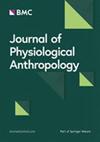High prevalence of rheumatoid arthritis and its risk factors among Tibetan highlanders living in Tsarang, Mustang district of Nepal
IF 2.1
4区 医学
Q1 Social Sciences
引用次数: 8
Abstract
In Tsarang (at 3560 m), which is located in Mustang, 62.7% of the residents answered that they had a subjective medical history of arthritis, and 41.1% of the residents answered that their families had a subjective medical history of arthritis on a survey conducted in 2017. The expression of hypoxia-inducible factor (HIF) and its effects are deeply involved in hypoxic adaptation in Tibetan highlanders. At the same time, HIF is also related to the onset of rheumatoid arthritis. Therefore, the adaptive mechanism acquired by Tibetan highlanders may promote the development of rheumatoid arthritis. The prevalence of rheumatoid arthritis is estimated to be approximately 0.5–1.0% worldwide. The objective of this study was to estimate the prevalence of rheumatoid arthritis in Tsarang residents using existing diagnostic criteria and to explore its risk factors. An epidemiological survey was conducted in Tsarang in 2019. Data obtained from anthropometry and questionnaires were statistically analyzed. Biochemical measurements using blood samples were also performed, and the results were used to assess arthritis status. Residents’ joint status was scored, and arthritis was assessed based on the clinical disease activity index and ACR/EULAR 2010 criteria. Twenty-seven males and 50 females participated in this survey. In Tsarang, ACR/EULAR 2010 classified 4.3% of males and 7.1% of females as having rheumatoid arthritis, indicating a very high estimated prevalence. We also performed a multivariate analysis to explore its risk factors, and two factors, older age (standardized parameter estimate = 4.84E−01, 95% CI = [9.19E−02, 8.76E−01], p = 0.0170) and a history of living in urban areas (standardized parameter estimate = − 5.49E−01, 95% CI = [− 9.21E−01, 1.77E−01], p = 0.0050), significantly contributed to the higher ACR/EULAR 2010 score in females. In addition, three factors, having no spouse (standardized parameter estimate = 3.17E−01, 95% CI = [5.74E−02, 5.77E−01], p = 0.0179), having a smoking habit (standardized parameter estimate = 2.88E−01, 95% CI = [1.71E−02, 5.59E−01], p = 0.0377), and a history of living in urban areas (standardized parameter estimate = − 3.69E−01, 95% CI = [− 6.83E−01, − 5.60E−02], p = 0.0219), resulted in significantly higher clinical disease activity index scores in females. Furthermore, smoking habits were found to significantly increase blood hyaluronic acid in both males (standardized parameter estimate = 6.03E−01, 95% CI = [3.06E−01, 9.01E−01], p = 0.0020) and females (standardized parameter estimate = 4.87E−01, 95% CI = [5.63E−02, 9.18E−01], p = 0.0291). In this study, we evaluated the symptoms of arthritis and estimated the prevalence of rheumatoid arthritis using classification criteria for Tibetan highlanders who have adapted to the hypoxic environment and fostered their own culture. The high prevalence of rheumatoid arthritis among Tsarang residents suggests that the hypoxic adaptation mechanism involving HIF in Tibetan highlanders may promote the onset or exacerbation of rheumatoid arthritis. The high prevalence of rheumatoid arthritis among Tibetan highlanders may be related not only to the environmental factors analyzed in this study but also to hypoxic adaptation genes. Further investigation is needed to clarify the genetic factors involved.类风湿关节炎在尼泊尔野马区察朗藏族高地居民中的高患病率及其危险因素
在野马州的察朗(海拔3560米),在2017年进行的一项调查中,62.7%的居民回答他们有关节炎的主观病史,41.1%的居民回答他们的家庭有关节炎的主观病史。缺氧诱导因子(HIF)的表达及其影响与青藏高原人的缺氧适应密切相关。同时,HIF也与类风湿关节炎的发病有关。因此,青藏高原人获得的适应机制可能促进类风湿关节炎的发展。类风湿关节炎的患病率估计在全世界约为0.5-1.0%。本研究的目的是利用现有的诊断标准估计察朗居民类风湿性关节炎的患病率,并探讨其危险因素。2019年在查朗进行了流行病学调查。通过人体测量和问卷调查获得的数据进行统计分析。使用血液样本进行生化测量,结果用于评估关节炎状态。根据临床疾病活动指数和ACR/EULAR 2010标准对居民关节状态进行评分,并对关节炎进行评估。27名男性和50名女性参与了这项调查。在查朗,ACR/EULAR 2010将4.3%的男性和7.1%的女性归类为类风湿关节炎,表明估计患病率非常高。我们还进行了多因素分析以探讨其危险因素,年龄(标准化参数估计= 4.84E−01,95% CI = [9.19E−02,8.76E−01],p = 0.0170)和城市生活史(标准化参数估计= - 5.49E−01,95% CI = [- 9.21E−01,1.77E−01],p = 0.0050)是女性较高的ACR/EULAR 2010评分的显著因素。此外,无配偶(标准化参数估计= 3.17E−01,95% CI = [5.74E−02,5.77E−01],p = 0.0179)、有吸烟习惯(标准化参数估计= 2.88E−01,95% CI = [1.71E−02,5.59E−01],p = 0.0377)、有城市生活史(标准化参数估计= - 3.69E−01,95% CI = [- 6.83E−01,- 5.60E−02],p = 0.0219)是导致女性临床疾病活动指数得分较高的三个因素。此外,吸烟习惯显著增加了男性和女性的血透明质酸(标准化参数估计= 6.03E−01,95% CI = [3.06E−01,9.01E−01],p = 0.0020)和女性(标准化参数估计= 4.87E−01,95% CI = [5.63E−02,9.18E−01],p = 0.0291)。在这项研究中,我们评估了关节炎的症状,并估计类风湿关节炎的患病率使用分类标准的西藏高原人已经适应了低氧环境和培养自己的文化。Tsarang居民中类风湿关节炎的高患病率表明,西藏高原人HIF的缺氧适应机制可能促进类风湿关节炎的发病或恶化。藏族高原人类风湿关节炎的高患病率可能与本研究分析的环境因素有关,也可能与缺氧适应基因有关。需要进一步调查以阐明所涉及的遗传因素。
本文章由计算机程序翻译,如有差异,请以英文原文为准。
求助全文
约1分钟内获得全文
求助全文
来源期刊

Journal of Physiological Anthropology
Social Sciences-Human Factors and Ergonomics
CiteScore
4.80
自引率
6.50%
发文量
39
审稿时长
>12 weeks
期刊介绍:
Journal of Physiological Anthropology (JPA) is an open access, peer-reviewed journal that publishes research on the physiological functions of modern mankind, with an emphasis on the physical and bio-cultural effects on human adaptability to the current environment.
The objective of JPA is to evaluate physiological adaptations to modern living environments, and to publish research from different scientific fields concerned with environmental impact on human life.
Topic areas include, but are not limited to:
environmental physiology
bio-cultural environment
living environment
epigenetic adaptation
development and growth
age and sex differences
nutrition and morphology
physical fitness and health
Journal of Physiological Anthropology is the official journal of the Japan Society of Physiological Anthropology.
 求助内容:
求助内容: 应助结果提醒方式:
应助结果提醒方式:


